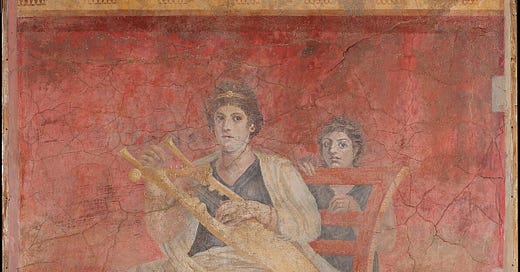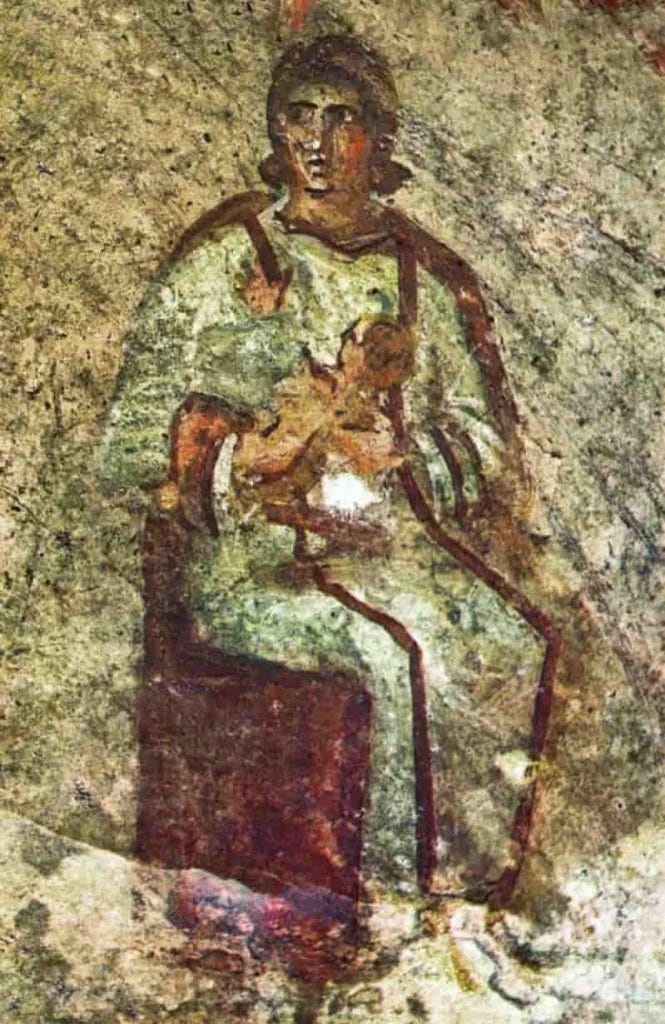In The Everlasting Man G.K. Chesterton makes the comparison between the early man, living in caves creating art, and then the New Man, Christ, as shown in much iconography, born in a cave. The old man was born in a cave and the New Man was born in a cave. And the link between the presence of God and art is no accident.
The old art was born in a cave and a New Art was born in a cave, that is the Christian catacombs. Factually, it’s pretty much impossible to know when Christian art began and considering that Christianity grew out of ancient Judaism from a historical perspective the early church was guaranteed to have issues with the whole idea of images and their use. But starting Christian art in the catacombs is logical because that’s what most people think of when they think of the early church.
The relation of the early church to art was not what it would become once it was formalized at the Second Council of Nicea. That they were using images in some locations is apparent and that there was contention is also apparent, but the aesthetic theory behind the images that were used is the interest of this essay not the biblical theology behind their mere presence.
The status of paganism by the time of the Christian advent, according to Jaroslav Pelikan, had come to a point where they had spurned their own myths and spiritualized them so as to take them away from any material images.
“And just when the leaders of pagan thought had emancipated their picture of the divine from the crude anthropomorphism of the mythological tradition, the Christians came on the scene with a message about one who was called “Son of God.” It is not surprising, when “the most learned and serious classes…are always, in fact, the most irreverent towards your gods,” that these classes should also have been the ones who vehemently resisted this message, which seemed to be a relapse into “a physical meaning of a gross kind,” the very thing from which, after a hard struggle, they had been rescued.”
Aristocrats dare not believe that God had come in such a fleshly manner. The sophisticated Roman would be able to see the allegorical truth in the myths. The Christian apologists had to maneuver their way between the doctrine of creation ex nihilo and the incarnation. What was the way to develop a belief that God and matter were not eternally coexistent but that God also came and had direct interaction with the material so as to be it. Their focus in answering this dilemma came back to the nature of the Trinity and that the monotheism found in the doctrine did not negate the economy of Christ, or physical appearance.
The Trinity was a confirmation not of just the economy of Christ but the very ability to use Greek and Hebrew philosophies. Indeed many apologists argued that Moses preceded Plato. Christians were able to thus bless the cultures of the world as being replete with traces of Logos which were to be brought into the new faith practices. No one had to become Jewish to be a Christian. The universal and the particular were brought together so as to have no contention between them. Gregory of Nyssa summarizes “Yet again, of the Jewish conception, let the unity of the nature stand; and of the Greek only the distinction as to persons…” (Oration 23.8)
Practically this led to the cultural practices that seemed forbidden in Judaism, like images, to be reexamined. Now that the use of images was underway in a limited sense there had to be a justifying theory as to the presence of the divine in the material in cultural terms since the apologists had inserted that as the justification of the redemption of cultural forms. If the Logos was present beforehand it had to be present now as well.
In Greek art there was the advent of geometry and visualizing of emotions. The Romans made many copies and subtle improvements on the Greek types. The Christians likewise continued the tradition, taking Roman art and using its style as their own. In the Roman work there was inherited a strange interplay between the real and the ideal. In a wall painting at a villa in Boscoreale called Lady Musician and Young Girl the combination of shading and detailed face and her general lack of elegance is an example of this real and ideal cohabitation.
When compared to a Christian work of similar topic, the Madonna and Child from the Catacomb of Priscilla in Rome from the third century AD, there is an obvious lack of interest in the combination of the real and the ideal. It is the opposite in a way. The flatness is not canceled out by the highlights. In fact they seem to insist on the flatness. And yet its nascent naturalism is countered by the symbolism where the form is illuminated from the inside rather than the outside.
The symbolic became far more important than the natural image as the Christians preferred to communicate with stories and metaphors and allegories. The naturalism of the stories were unimportant and a distraction from the important messages found in the comparison of real things to spiritual truths. If they had a disdain for the material world it was not out of a view of its lack of interpretive power.
Primarily the Christian viewed the ideal as being absent from the earth since, in their view of history, the culmination of beauty on earth was yet to be seen. In some sense they did develop a view of historical progression as opposed to a cyclical one. The Christian view of history was both a continuation and a rebirth. Many of the apologists argued that the ancient philosophers had known the truth of the Hebrew God and over time had lost most of the truth but retained the wisdom. The advent of Christ was that restart where all the nations could rekindle their knowledge and bring themselves back to Him. So art, though it was seen as a realm of truth that could be reclaimed, also had to essentially start over with the Christian mind in order to bring about its full potential.
The suspicion of images was not only an inherently Christian holdover from Judaism but also was founded in some suspicion from the Roman philosophers themselves. To the masses one of the popular philosophies was Epicureanism. According to their theory images of things are made up of simulacra which was a membrane like substance that penetrated the eye and landed on the organ of vision within the eyes. Because of their ability to remain in the eye and mind long after beholding the image itself, simulacra were untrustworthy and could even deceive the untrained mind according to Lucretius. Lucretius is a philosopher where we find the connection between the image and the lust of the flesh, or sexual desire. Simulacra in the eye is the cause of desire in the man who is looking upon the desired object. It triggers all the bodily functions associated with sexual desire and so sexual desire itself becomes associated with images. Asceticism was the only way to rid oneself of this problem, a strict avoidance of all images.
For Lucretius the result of this was not acceptance of the process but a rejection because, through more violent tendencies, the man attempts to possess the image itself. The association between images and the lust of the flesh would not have been lost on Christian who were strict sexual moralists. The love induced by an image was a shallow love. An obsession with the external form. If this relationship was established then the Christians would have had a difficult time justifying the use of images to portray people.
The change of Christians claiming the redemption of the material world to them associating the material world with a sort of shame was quick, if not always there in some respect. It was only when the concept of shame was lifted that the material world was allowed to be portrayed in its own glory. Until then the Christians had to resolve this by ensuring the images produced a covering of that shame so the content could be set forth. Their focus on drapery and clothes was the way in which “treating other persons and things with awe, for restraining the desire to look, to invade with the eyes, is that we find ourselves in a world with depth, in a world where the visible surface, the facade or mask, expresses rather than hides an infinite profundity.” - Colin Barton, The Roman Gaze
The drapery and modesty was designed so that the images could be looked at without a transmission of unnecessary shame and honor. For the Romans to not look at something was in a way to give it honor and to lay shame over yourself. To have things on which it was at times improper to look at allowed the Romans to have gods and sacred things. To stare or talk about something deemed shameful would be to uncover their “veil of clothing” and expose their shame. So even images of saints, who covered themselves in heavy garb, could be exposed in shame. The balance between the sacred and the profane was thin in imagery. Shame was the basis of the fight between the iconoclasts and the iconodules. How could shame and holiness be conjoined in material reality?





